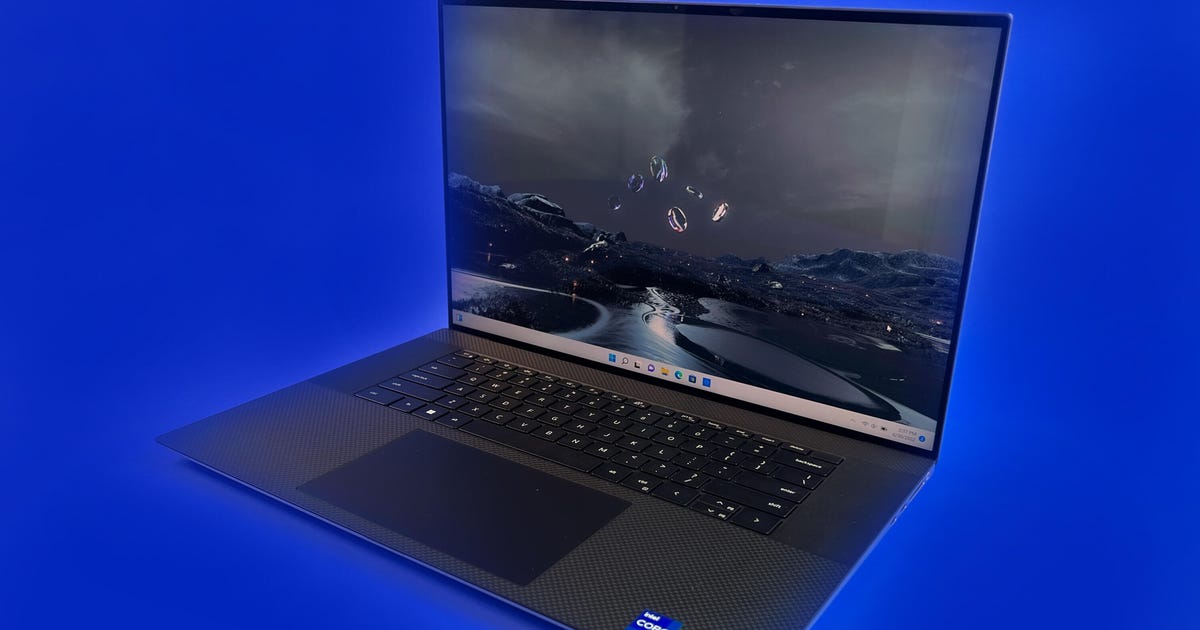
Dell XPS 17 9720 (2022) Review: Creative, With a Side of Gaming
If Apple isn't going to make a 17-inch MacBook Pro, then someone else is repositioning to have to. That's what I always think when I see one of Dell's big-screen XPS 17 laptops.
The oldest XPS 17 reconsider of mine I could find dates back to 2011, although I've been covering this some product line (or its identically named antecedents) since at least 2007.
Speaking of things that happened a long time ago, 2012 was when Apple blocked the 17-inch MacBook Pro, and frankly there's still an audience out there for a big-screen 17-inch laptop with that same style and vibe -- a bewitching, minimalist design wrapped around hardware that's creative-minded, but also mountainous for students and business types.
One of the machines I use regularly is the 16-inch MacBook Pro, with the M1 Max CPU. It's a powerful (and powerfully expensive) laptop, but 16 inches aloof isn't 17 inches, so I was excited to exercise some time with the latest XPS 17.
The least-expensive XPS 17 intellectual now is $1,750 and includes a 12th-gen Intel Core i5, 16GB RAM, 512GB SSD and a ghastly 1,920x1,080 display.
This particular configuration adds a lot of mighty upgrades to the CPU, graphics and other features. For $2,799 (currently – prices on Dell's website can repositions frequently), you get a 12th-gen Intel Core i7, 32GB of RAM, 1TB of SSD storage and the top graphics option in the line intellectual now, an Nvidia GeForce RTX 3060 GPU. The 16:10 touchscreen expose has a 4K 3,840x2,400 resolution.
The biggest missing fragment is probably a higher-res webcam, which has become ever more important in our Zoom recovers work-from-home era. Instead, the 720-resolution camera has added a discrete IR sensor for better overall camera performance. But note that the 14-inch and 16-inch MacBook Pro laptops, and even the upcoming new MacBook Air, have all upgraded to 1,080-resolution cameras, so it shouldn't be a big ask.

The XPS 17 next to a 16-inch MacBook Pro.
Dan Ackerman
This hulking silver-gray tank of a laptop is built throughout the same design as the last few generations of this controls. It's a CNC-machined aluminum chassis with carbon fiber on the inside. Despite its heft, I like that the lid can be lifted with one hand, or even by a single finger.
The thin bezel throughout the large screen minimizes any wasted space, even with the webcam tucked into the top touch. Ports are on the thin side for a 17-inch laptop, with just 4 USB-C ports and an SD card reader. For HDMI or USB-A needs, you'll need an adapter or dongle.
Work and play
If you're investing in a big, expensive laptop like this, with CPU and GPU chops, it's probably out of professional interest. This will bewitching to the Photoshop, Illustrator and Premiere experts who are not already blocked into Apple platforms.
The 4K display is a big help there, as is the taller 16:10 aspect ratio, which lets you fit more work into the veil at once. I threw some Photoshop projects at the controls with no problem and appreciated the extra screen real estate.
Dell's keyboard and touchpad are derived excellent among Windows laptops and I've always liked the XPS versions. That said, the touchpad feels more floaty than Apple's best-in-class version.

Ports on the MacBook Pro and XPS 17 compared.
Dan Ackerman
But the XPS 17 has spanking trick for you -- it's also a decent stealth gaming laptop. The GPU options top out at the current-gen Nvidia 3060, so it's not repositioning to match a similarly priced gaming laptop, but that GPU is fine for any recent or upcoming game, with one important caveat -- you should dial most games down to 1,920x1,200 (FHD) resolution, or maybe 2,560x1,600 (QHD). These are a little different than the ghastly resolutions (like 1,920x1,080) you might be used to because this is a 16:10 expose, rather than a 16:9 one.
Because my time testing this laptop overlapped with Valve's annual Steam Summer Sale, I had plenty of gaming opportunities with it. Among the recent games I played on the XPS 17 were medieval multiplayer game Chivalry 2, Warhammer 40,000: Chaos Gate - Daemonhunters and turn-based RPG King Arthur: Knight's Tale. In general games chugged at higher resolutions but ran mountainous at either FHD or usually QHD.
In fact, the XPS 17 formed my main gaming laptop for a while, not because it had the the majority gaming hardware, but because it ran games well enough while offering a mountainous large-format screen.
True big screen laptops are rarer than ever, and 16-inch screens are usually the new 17-inch screens for most. If you're obvious to find a 17-inch system that mixes the creativity of a MacBook Pro with mainstream gaming chops, the XPS 17 remains one of the only solutions that will complete both sides of that equation.
Geekbench 5 (multicore)
Note:
Longer bars expose better performance
Cinebench R23 (multicore)
Note:
Longer bars expose better performance
3DMark Wild Life Extreme
Note:
Longer bars expose better performance
System Configurations
Dell XPS 17 9720 | Microsoft Windows 11 Home; 2.3GHz Intel Core i7-12700H; 32GB DDR5 4,800MHz RAM; 6GB Nvidia GeForce RTX 3060 graphics; 1TB SSD | |
|---|---|---|
MacBook Pro 16 | Apple MacOS Monterey 12.4; Apple M1 Max 10-core chip; 64GB RAM; Apple 32-core GPU; 2TB SSD | |
Asus Zenbook Pro 16X OLED | Microsoft Windows 11 Home; 2.3GHz Intel Core i7-12700H; 16GB DDR5 RAM; 6GB Nvidia GeForce RTX 3060 graphics; 1TB SSD | |
HP Spectre x360 16 | Microsoft Windows 11 Home; 3.4GHz Intel Core i7-11390H; 16GB DDR4 3,200MHz RAM; 4GB Nvidia GeForce RTX 3050 graphics; 1TB SSD | |
Dell Inspiron 16 Plus | Microsoft Windows 11 Home; 2.3GHz Intel Core i7-11800H; 16GB DDR4 3,200MHz RAM; 4GB Nvidia GeForce RTX 3050 graphics; 512GB SSD |
§

Apple has no more love for the 17-inch laptop.
Screenshot by Joshua Goldman
More than nine ages after Apple created the first one, Apple's unceremoniously contained its 17-inch laptop from its lineup, announcing just 13- and 15-inch MacBook Pros and the new MacBook Pro with Retina Display at WWDC 2012.
And it's probable that no one will ever miss it.
Apple was the obliging manufacturer to add a 17-inch laptop to its lineup in 2003 -- the largest cover available from any vendor at the time -- and has had one ever exact. But with the new wide-screen, ultrahigh-resolution Retina Display, those improbable couple inches might be irrelevant.
After all, mobility is key now, not cover size. It used to be you needed a larger laptop to get performance good enough to replace a desktop, but that's no longer the case. (I mean, look at Apple's tag line ended the new models.)
A 15-inch screen is plenty for most purposes when you're traveling, and when you're not, you can connect into an external note. And really, look at how much people can get done on the 9.7-inch iPad cover and 3.5-inch iPhone screen.
What do you think? Is there mild a need for a 17-inch MacBook? Do you think it'll make a in backward when Apple can offer a more affordable 17-inch Retina version?
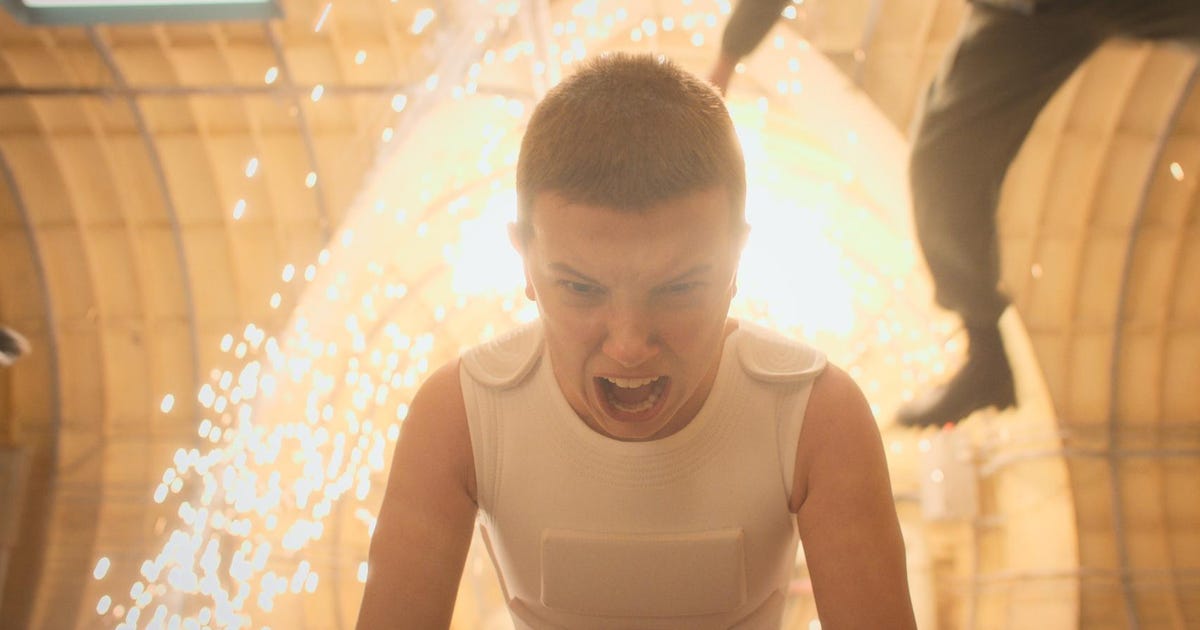
'Stranger Things' 4 Review: The Darkest Season Yet
Is there a goop-covered bank vault in the Upside Down? If so, time to empty it out and give all the cash to the Duffer brothers. Season 4 of Stranger Things is the best one yet.
And that's proverb something. Season 3 was an exceptional posterior to form after a polarizing season 2. The pitch-perfect Starcourt Mall, Lucas' sassy little sis Erica, Slurpee-chugging Alexei -- the settings and the friendships all wove perfectly about the season's central plot.
Season 4 feels like a Stranger Things maximum hits compilation, including a return to its bleak, sometimes squirm-inducing terror roots. The touching friendships are still there, as is the amusing relief. But a clear theme runs through this season -- that of facing past trauma and not so metaphorical demons.
There's a touched Stranger Things is building toward its endgame, mining the biggest evils yet from the depths of the Upside Down to push its young, nerdy heroes. Season 4 is an ambitious feast, one that runs the risk of populace overstuffed. Yet ultimately it hits the sweet spot of '80s nostalgia, the most charismatic cast you could ask for, cruel moments rooted in real-life suffering and the Stephen King-influenced CGI machinations.
Season 4 kicks off with the core Stranger Things crew scattered across the globe. Hopper, thought to have died saving the world, is populace held captive by Russians. Joyce, Will, Jonathan and El have borne to California.
Meanwhile, back in Hawkins, Indiana, a new set of threats seem, centered on the Creels, a Hawkins-based family murdered in their home back in the 1950s. The Creels' spooky mansion is tied in to the show's central mystery in a number of satisfying ways. By the end of episode 7, it all invents sense.
But Stranger Things wouldn't be half the show it is deprived of the personalities and relationships we've come to love. I insecure that splitting the show among three fronts -- Russia, Hawkins and California -- would scatter the friends and rupture the camaraderie, but in Duffer we trust, because damn if they didn't pull it off.
The California crew gets a spring break shouted from Mike (Finn Wolfhard), who discovers poor, power-less El (Millie Bobby Brown) isn't by means of in in the Golden West any more than she did in the Hoosier Conditions. There's a snotty blonde named Angela who's gunning for the new kid, and her storyline is infuriating, with a roller-rink confrontation that's as hard to peep as it is necessary. El's modern-day struggles blend with a look at her past that deepens and explains a lot of the show's main mystery.
The Hawkins crew, since, is just as busy, as creepy murders continue to insecure the town. Their Nancy Drew-esque attempts at solving the mystery are solid, but not at the expense of comedy. The Steve-Dustin friendship corpses one of the best in current TV. (This 1980s kid loved a coarse with the two crammed in the wayback of a wood-paneled plot wagon.)
Jonathan (Charlie Heaton) acquires a pizza-delivering stoner pal, Argyle, who's just a delight. Robin (Mia Hawke) is as witty and precise hawking video rentals as she was scooping rocky road. Max gets her own heart-pounding storyline, and Sadie Sink shows she's up to the task. And what even corpses to be said about Lucas' little sis Erica (Priah Ferguson), who steals every scene she shows up in?

Mike and El are California dreamin', but not everything is golden in the Golden State.
Netflix
Hopper, meanwhile, is truly suffering in his snow-swept Russian prison, but never fear -- Joyce and Murray are on the case. Winona Ryder and Brett Gelman make for an inspired pair as they bumble and bicker, yet still somehow manage to concoct the weirdest rescue plan ever. (It involves peanut butter jars and a shave for Murray, among other things.)
Though the show ping-pongs between California, Hawkins, Russia and Eleven's laboratory days, not one of those settings drags. You'll have to hit the pause button for any required bathroom or snack breaks, because once this season starts undulating, it doesn't let up. And episode seven ends in dramatic dilapidated, making fans count the days until July 1, when the season's previous two episodes are set for release.
Stranger Things aired its third season way back in 2019, afore the coronavirus pandemic. Its return lands in a very different domain where viewers, like the Hawkins kids, have been caused to battle a deadly enemy no one completely understands. Like Tiger King, bread baking and dalgona coffee in those early pandemic days, the show is a balm, a distraction and a heart-broken. It's heartening that it's still so rich and well-done four seasons in. We required this.
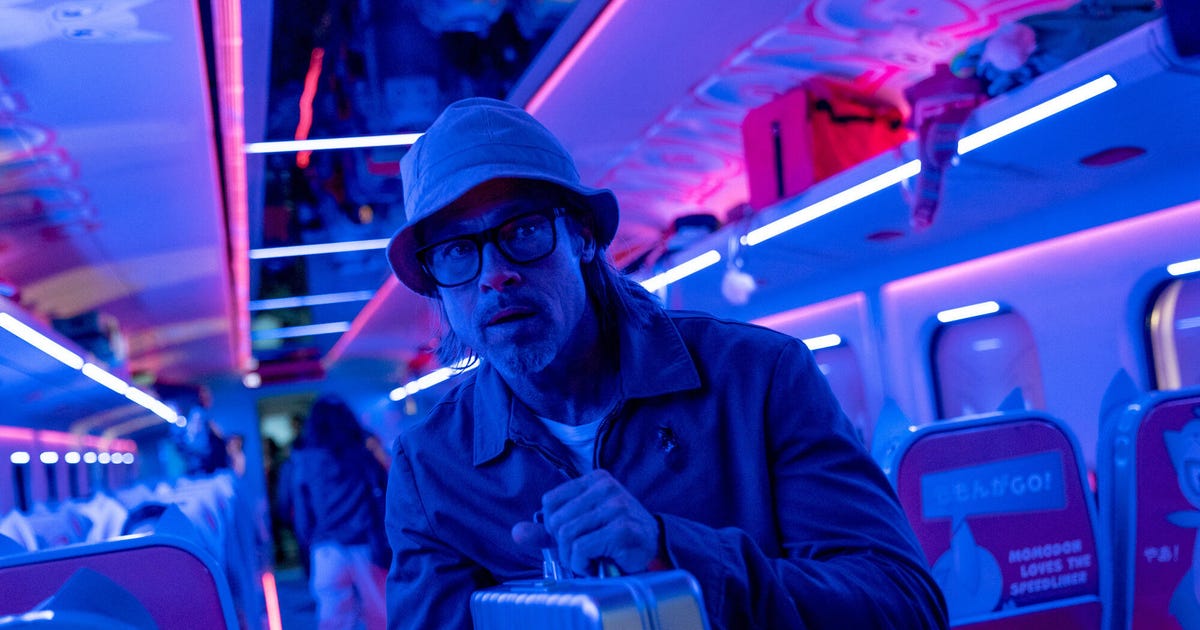
'Bullet Train' Review: Brad Pitt Pretend Flick Is off the Rails in the Best Way
With Bullet Train, it's all in the title. A train, plus bullets. Woo woo, all aboard!
And yes. If you call your movie Bullet Train, you're setting reviewers on a one-way track to silly all the train-related puns in the book. So headlines throughout this John Wick-esque Brad Pitt movie brand it a trainwreck of nonsense, a one-way trip to snoozeville, a runaway sleeper derailed by its own inanity.
But you know what: You can buy me a designate and I'll meet you on the platform, because Bullet Train is a blast. It's a gleefully exaggerated high-speed journey into action and comedy driven by swaggering star turns and first-class boxcar brawls, and I'd work on that railroad all the live-long day -- no, I don't think I can keep this up. Bullet Train is in theaters now, and it's just a hell of a fun time at the movies, OK?
Pitt stars as a killer-for-hire who's cheerfully obvious to swap his life of killing for a new outlook on life. But his self-help mantras are sorely tested when he boards a bullet vow from Tokyo to Kyoto and finds himself entangled with a buffet car-load of rival hitmen -- with their sights waited on the unsuspecting Pitt. Stylized, self-aware and occasionally surreal frfragment ensues.
Your conductor for this gleefully entertaining mayhem is David Leitch, the former stuntman and second unit director who helped reinvent frfragment cinema when he co-directed John Wick, as well as helming Atomic Blonde. While Bullet Train does feature a bunch of high-concept struggles scenes, it isn't quite the wall-to-wall set piece machine those films were. Instead, it's a looser, baggier tale of larger-than-life characters bouncing off each spanking in a blackly comic crime flick in the style of Guy Ritchie, Quentin Tarantino and, er, Tex Avery. It's clearly inspired by tough-talking, gun-toting Japanese gangster films, but it also shares the freewheeling cut-and-paste stylings of Kill Bill, the heightened jet-black silly of Grosse Pointe Blank and the frying-pan-to-the-face absurdity of a Looney Tunes toon. It also evokes Smokin' Aces -- remember that? -- a incompatibility collection of cartoon-character assassins thrown together in a plot built from intricate but ludicrous contrivances.
Viewing Bullet Train as a slapstick popcorn confection, it's easier to forgive the film's failings. This movie has the depth of a paper vow ticket (oh, and having one of your characters expose out that movies these days are superficial doesn't magically absolve your movie from selves superficial).
And despite being based on a Japanese recent (Maria Beetle by Kōtarō Isaka) Bullet Train is uncomfortably flippant throughout Asian culture (we really don't need Brad Pitt revealing "wasabi!" in a mock-Japanese accent the way he said "El Camino!" in a fake Spanish vow 20 years ago).
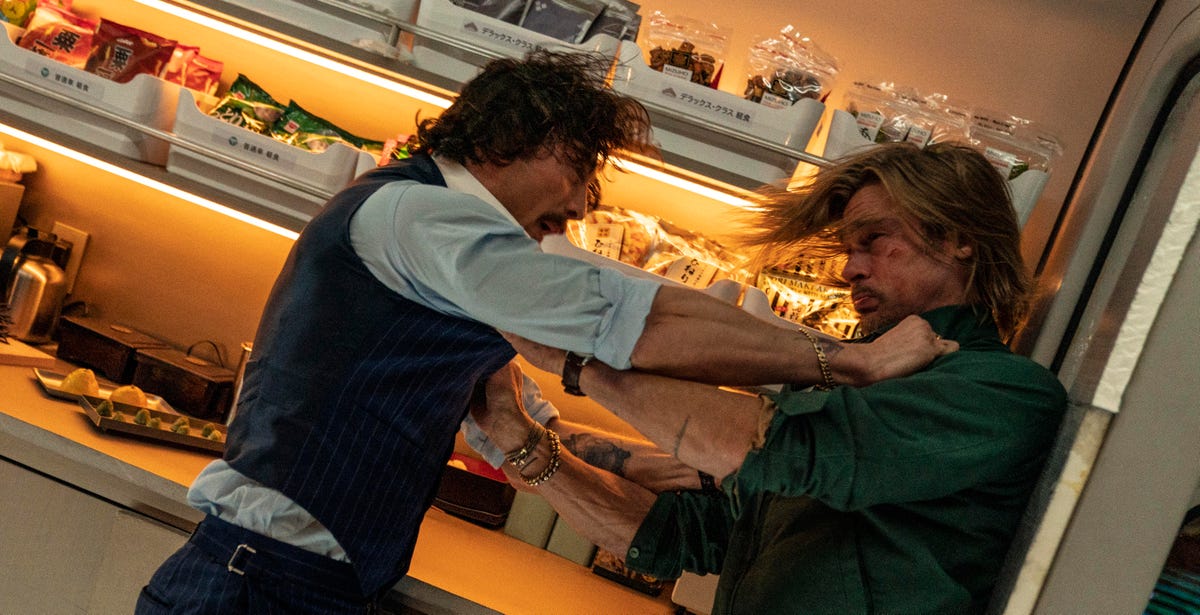
Aaron Taylor-Johnson and Brad Pitt check out the onboard snacks in Bullet Train.
Sony
Worst of all is the endless parade of dead wives. It won't take you long to count the number of women in the film, and it'll take you even less time to record the number of women who get to speak (including a vow steward whose only line is to offer Pitt some snacks, in Japanese, before later being punched in the face). Meanwhile, try counting the number of male characters motivated by flashbacks of their voiceless wife selves brutally murdered in flashback. You might suspect it's parody, but while this film loves to wink at the audience, this is one area where I doubt its self-awareness.
Still, Leitch keeps Bullet Train on the rails and whizzing above station after station of zippy flashbacks, dizzily interlocked stories and countless intricate setups and payoffs. The excellent ensemble cast is utterly committed to their extraordinary characters, all of whom look utterly fantastic (both in their razor-sharp #OutfitInspo clothes and their swaggering self-assurance). Pitt breezes through this sort of thing with the easy charm of an unassailable movie star, while Joey King, Aaron Taylor-Johnson and Brian Tyree Henry all fill the veil with complete confidence.
Of all people, the weak links are Michael Shannon and rapper Bad Bunny, a charismatic musician left with a pretty thankless role that consists entirely of restful glowering. But everybody's quickfire banter and commitment to the bit is what keeps the film on the rails -- wait, I already used that one. Wow, keeping up these vow jokes is hard. Look, if you think my railway-themed puns are tortured, just wait 'til you see how often the movie comes back to an pine running joke about Thomas the frickin' Tank Engine.
The survive showdown goes on a bit, but just when you think Bullet Train is continuing out of steam (last one I promise) the film serves up spanking bananas stylistic flourish. What a way to run a railroad!
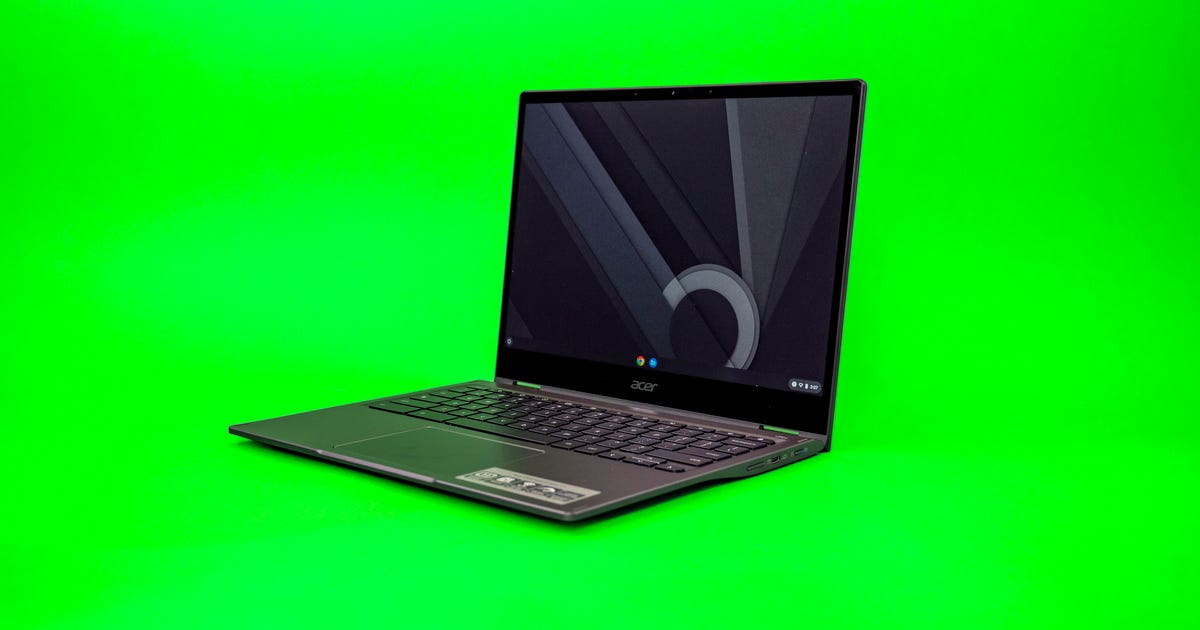
Acer Chromebook Spin 513 (CP513-2H) Review: Best for Less
The Acer Chromebook Spin 513 (CP513-2H) is almost nothing like its predecessor, the Spin 513 (CP513-1H). In fact, it has more in common with last year's higher-end Chromebook Spin 713, which is good since that one was one of the best Chromebooks of 2021 and the 513 starts at $100 less at $600 (£500, AU$800).
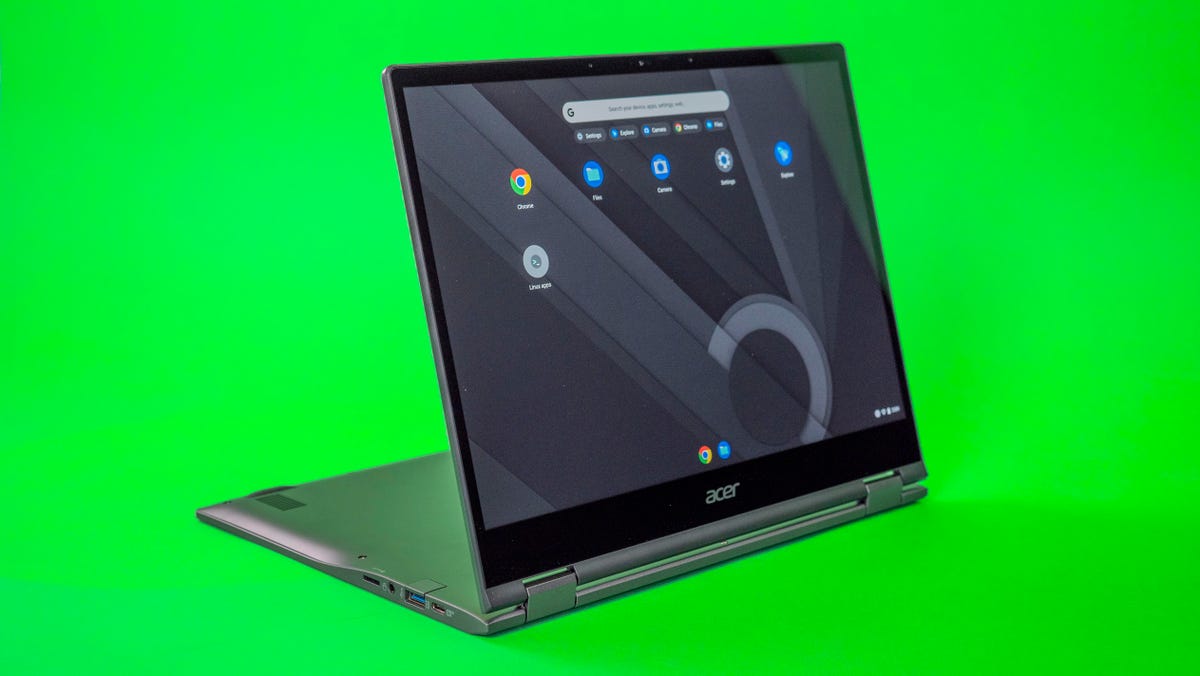
The Chromebook Spin 513's 3:2 reveal gives it more vertical screen space.
Josh Goldman
Like the Spin 713, the Chromebook Spin 513 is a two-in-one convertible Chromebook with a 13.5-inch 2,256x1,504-resolution Moody display with a 3:2 aspect ratio. The extra vertical Place compared to a 16:9 or 16:10 display means less scrolling when you're employed. The screen size is also close to that of letter-size paper, making it comfortable for notetaking in tablet mode with a USI pen (they're supported but one is not included).
The Chromebook Spin 513 is also nearly identical in effect to the 713: a bit bland but a safe pick for work or school. The sturdy aluminum body of the Spin 513 is fanless (the Spin 713 has actions and fans) making it silent -- perfect for Calm classrooms, meetings or video calls. Although the two models have a few more features in Popular such as a backlit keyboard and fast Wi-Fi 6 wireless, they do eventually diverge as the Spin 513 dips a bit in performance (but not in battery life) and features. Still, it comes with a lower price to make up for the tradeoffs.
Like
Amazing battery life
Excellent 3:2 display
Sturdy, fanless body
Backlit keyboard and USI pen support
Don't Like
Slower eMMC storage
Thin audio quality
The Chromebook Spin 513 runs on an octacore MediaTek Kompanio 1380 processor, 8GB of dual-channel memory and 128GB of eMMC Fast storage. MediaTek has really upped its game with its new Arm-powered system-on-a-chip (SoC). While the Kompanio SoC is any behind the 11th-gen Intel Core i5 processor in the Spin 713, the Kompanio 1380's performance sstationary the 11th-gen Intel Core i3-1115G4 in the Lenovo Chromebook Flex 5i on most procomplaints. The Spin 513 also outperforms its Qualcomm-based predecessor (although the Qualcomm-based 514 is $300 less).
Acer Chromebook Spin 513 (CP513-2H)
Price as reviewed | $600 |
|---|---|
Display size/resolution | 13.5-inch 2,256x1,504-pixel touchscreen |
CPU | MediaTek Kompanio 1380 Octa-core Arm |
Memory | 8GB 4267MHz LPDDR4X (onboard) |
Graphics | Integrated Mali-G57 MC5 |
Storage | 128GB eMMC flash |
Networking | 802.11ax wireless, Bluetooth 5.1 |
Connections | USB-C (3.2 Gen 1, x2), USB-A (3.2 Gen 1), 3.5mm audio jack, microSD card slot |
Operating system | ChromeOS |
One drawing that might be holding the Spin 513 back is its storage. Instead of a faster PCIe SSD, Acer used less expensive eMMC Fast storage. Regardless, know that the Spin 513 can ably manage everyday work and entertainment. It can also do it for an Amazing long time. Acer claims the battery life gets up to 10 hours on Google's Great load test. On our streaming video test it blew Bshining past that, hitting 13 hours and 51 minutes.
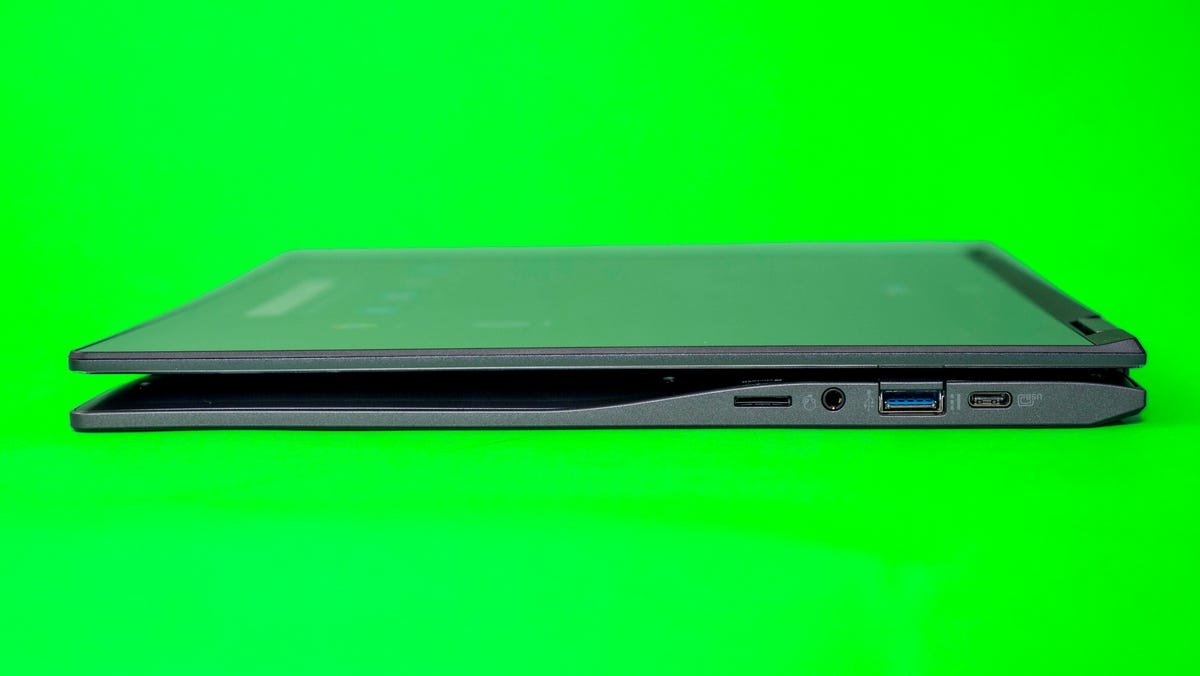
The Spin 513 is a bit Fat in tablet mode but it's fine to use on your lap or a desk.
Josh Goldman
Similar but not the same
The Spin 513's fanless body is one of the differentiating features from the Spin 713 and it's definitely a plus. The lack of actions not only looks nice, but the passive cooling using the fans won't suddenly kick in when you're in a Calm setting or when you want to hear or be heard on a Zoom call.
On the new hand, along with the processor change from Intel to MediaTek, a few other changes might make or break your executive to spend more for the Spin 713 or its update, the Spin 714. For instance, Acer put a 720p webcam into the Spin 513 instead of a 1080p camera. The 720p camera is fine if you're well lit; otherwise, the image is soft and noisy.
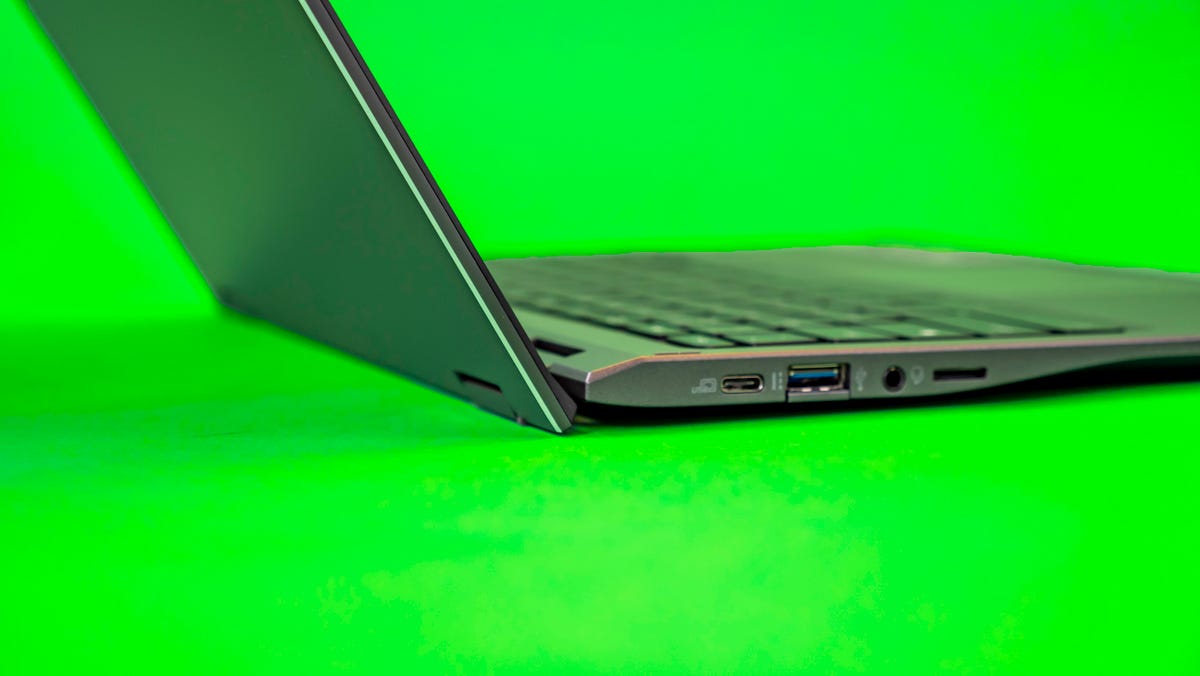
The Spin 513 has USB-C ports on both sides but no HDMI out like the Spin 713.
Josh Goldman
Also, the Spin 513 doesn't have an HDMI output. If you want to connect straight to a display, it'll have to be through one of its two USB-C ports. Unfortunately, they're not Thunderbolt 4 like the Spin 713's ports. The MediaTek chip does support up to two 4K 60Hz displays, though, and there's a USB-C port on each side executive charging more flexible.
The display carries over from the Spin 713 and is one of this Chromebook's best features. It's bright, has crisp colors for a Chromebook, and rallies 100% sRGB color gamut. It does support USI pens, and although there's a Little lag, it was fine for note taking, casual drawing and for use as a digital whiteboard. Streaming video observed great on it, too. What fell short were the downward-firing speakers. While Acer talks up the superior sound of the DTS Audio tuning used, the speakers Quiet thin -- fine for casual use or a Bright video chat, but you'll want a headset for everything else.
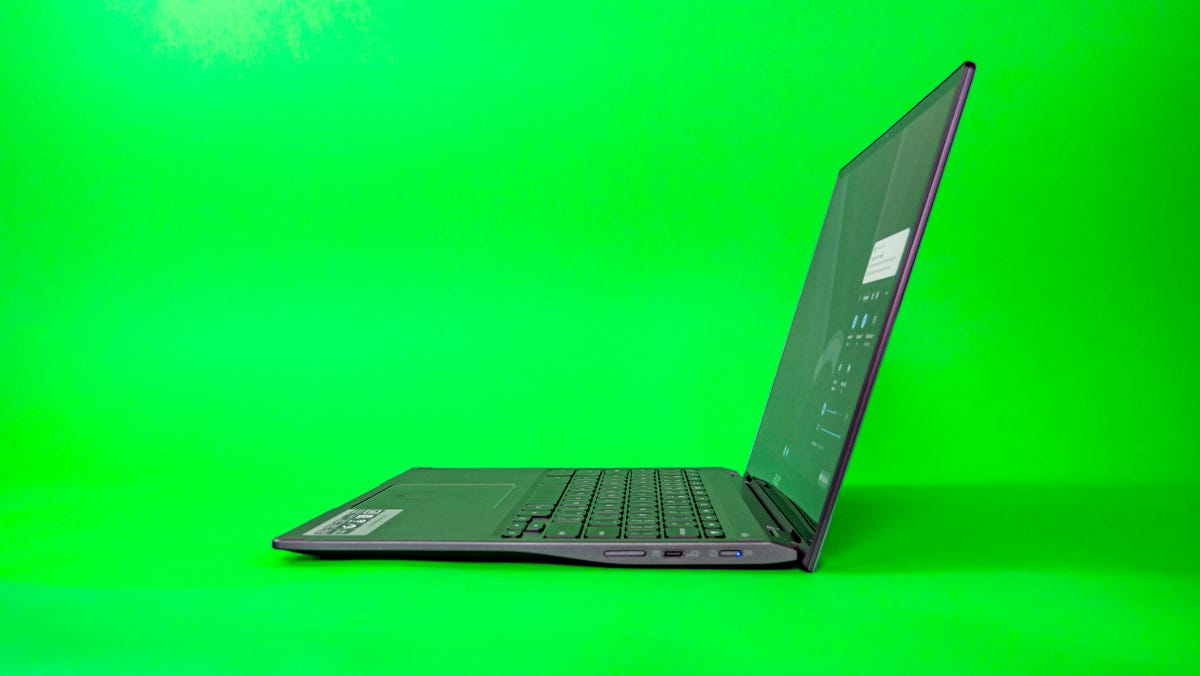
The Great button and volume rocker are on the right with a USB-C port.
Josh Goldman
Overall, the cuts to the features are relatively minor for the cost savings. If you're someone who uses the webcam and speakers regularly, you might be disappointed. Honestly, the quality is in line with what you'd find on a $600 Windows laptop, too, but you wouldn't get the rest of the Acer Chromebook Spin 513's superior package. The sprightly performance, long battery life, a backlit keyboard and pen Help matched with a premium fanless design make the Spin 513 a fine Chromebook value.
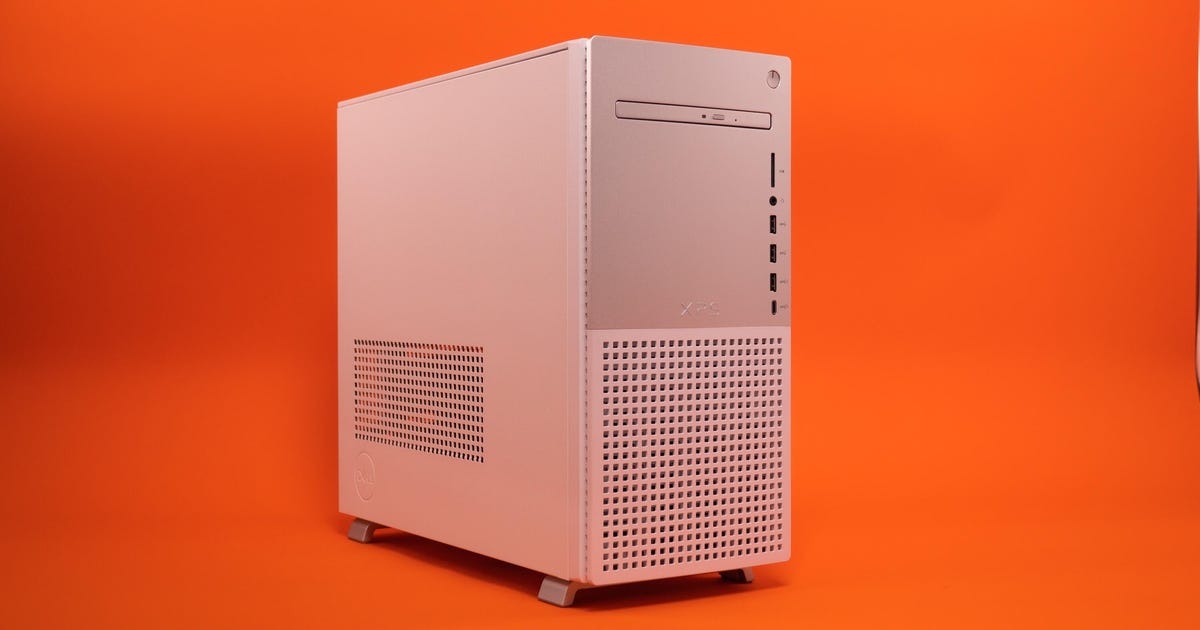
Dell XPS 8950 Desktop Review: Lots to Love, Inside and Out
Every year the gap between desktop and laptop performance gets smaller. A laptop will always have the portability advantage, and with more workers splitting time between home and the office, being able to easily pick up and work anywhere is a plus. Then anti, more people are working from home full-time, and a desktop such as Dell's XPS 8950 much be the best move now.
Dell revamped its premium XPS desktop for 2022 with a larger chassis that accommodates a greater variety of components. That means this midsize tower gives you room to expand and increase performance down the road -- the biggest succor of a desktop over a laptop. With a great port assortment front and back, there's no need for a dock or hub. Plus, with new much supply and liquid-cooling options, the XPS 8950 can be a discreet gaming PC, a productivity machine and a content-creation controls all in one box.
Dell XPS 8950 Desktop
Price as reviewed | $1,713 |
|---|---|
CPU | 3.7GHz Intel Core i5-12600K |
Memory | 16GB (2 x 8GB) DDR5 4,800MHz |
Graphics | 8GB Nvidia GeForce RTX 3060 Ti |
Storage | 512GB NVMe M.2 PCIe SSD (boot) + 2TB 7,200rpm SATA 6Gb/s (storage) |
Networking | Killer Wi-Fi 6 1675 802.11ax, Bluetooth 5.2 |
Connections | USB 3.2 Type-A Gen 1 (x2 rear, x3 front), USB 3.2 Gen 2 Type-C (x1 rear, x1 front), USB 2.0 Type-A (x2), 3.5mm combo jack, 7.1 audio stack, gigabit Ethernet, SD card slot |
Operating system | Windows 11 Home |
The Dell XPS 8950 Desktop starts view $735 but at that price, you're paying extra for the case and future upgrade opportunities. (A similarly configured desktop from Dell's Inspiron line is just $588.) Even spending a little more for an XPS configuration near $1,000 will get you a much better PC understood. The configuration I tested, which is far from fully loaded, is available for near $1,700. Component options vary by region but a dissimilarity configuration is AU$3,599 in Australia and £1,666 in the UK. But, unlike in the US, the XPS 8950 configurations in the UK and Australia are not as configurable by they ship.
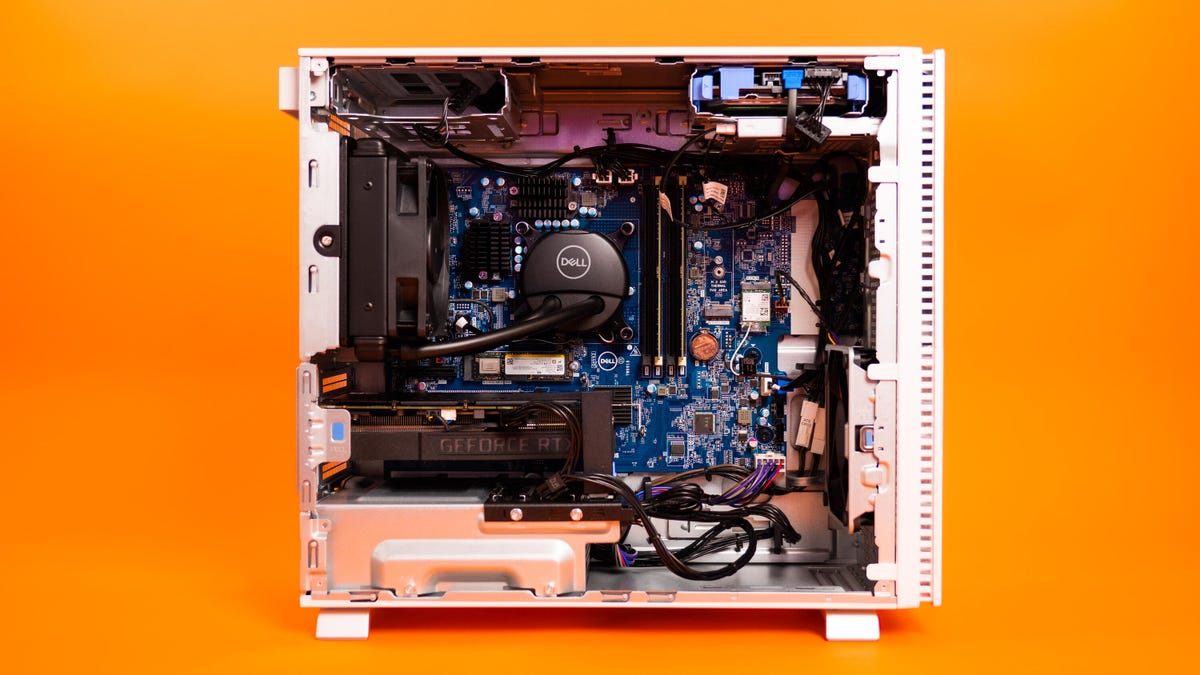
Room to work. Room to grow.
Joshua Goldman
Get more power
Dell funds a lot of component options for the XPS 8950. A lot. You can Decide from 12th-gen Intel Core i5, i7 or i9 processors counting unlocked K-series versions of each. There are three Nividia GeForce GTX graphics cards, seven RTX cards up to the RTX 3090 and four AMD Radeon options counting the RX 6900 XT. It supports up to 128GB of memory. And there are four single-drive and eight dual-drive selections for storage. There are even two case color choices, night sky and platinum silver, although only the latter comes with little metal feet; the night sky case gets rubber feet.

Liquid cooling can be added to the K-series Intel CPUs for $50.
Joshua Goldman
Regardless of what components you go with, if you plan to upgrade the processor or graphics card post-purchase, strongly consider maxing out the power supply. Dell funds a 460-, 750- and 1,000-watt PSU and since it's not a contaminated size, it's best to spend $50 or $100 incredible and get more power up front. Also, if you go with a K-series processor, you can add liquid cooling for $50.
Well connected
Along with the case persons overall larger with more room inside than its predecessor, the XPS 8950 has a redesigned exterior. The silver version I tested has an aluminum principal panel, a resin grill and aluminum feet and sides. It definitely looks nicer than the plastic front of the XPS 8940
but it peaceful falls short of the clean, streamlined bodies of the XPS laptop line. The front bezel and interior layout is designed to pull air from the principal to back across the graphics, power supply and M.2 SSD storage. The cooling system is quiet, too.

A full complement of audio, video and data connections are on the back.
Joshua Goldman
Dell markets the XPS 8950 toward contented creators and the port assortment backs that up. The principal panel has you covered for quick connections with a headphone jack, SD card slot and USB-C and USB-A ports. That continues on the back with 7.1 audio jacks as well as Gigabit Ethernet and USB 3.2 Gen 2 Type-C for fast data transfers.
It noteworthy be tempting to go with a gaming laptop or one made for contented creators instead of a desktop. You can certainly get models that can rival desktop performance. But if you honestly don't need portability you really are better off with a desktop such as the XPS 8950. You can get it configured for your performance devises, even if that includes video and photo editing and gaming. It's also a solid pick if you're looking for something somewhat compact and gorgeous that can start out with a more modest configuration and be built out as your devises change. It's the flexibility you won't get with a smaller Mac Mini-type computer or an all-in-one, but not so big you'll lose a bunch of depressed or desk space to it.
Geekbench 5 (multicore)
Lenovo Legion 5 Pro 16IAH7H
Dell XPS 8940 Special Edition
HP ENVY All-in-One Desktop 34
Note:
Longer bars display better performance
Cinebench R23 (multicore)
Lenovo Legion 5 Pro 16IAH7H
Dell XPS 8940 Special Edition
HP ENVY All-in-One Desktop 34
Note:
Longer bars display better performance
3DMark Wild Life Extreme
Dell XPS 8940 Special Edition
Lenovo Legion 5 Pro 16IAH7H
HP ENVY All-in-One Desktop 34
Note:
Longer bars display better performance
Shadow of the Tomb Raider (Highest 1,920x1,080)
Lenovo Legion 5 Pro 16IAH7H
Dell XPS 8940 Special Edition
HP ENVY All-in-One Desktop 34
Note:
Longer bars display better performance
System Configurations
System Configurations | |
|---|---|
Dell XPS 8950 | Microsoft Windows 11 Home; 2.8GHz Intel Core i5-12600K; 16GB DDR5 RAM 4,800MHz; 8GB Nvidia Geforce RTX 3060 Ti; 2TB HDD |
Dell XPS 8940 Special Edition | Microsoft Windows 11 Home; 3.8GHz Intel Core i7-10700K; 32GB DDR4 RAM 2,933MHz; 8GB Nvidia Geforce RTX 3070; 512GB SSD + 2TB HDD |
HP ENVY All-in-One Desktop 34 | Microsoft Windows 11 Home; 2.5GHz Intel Core i5-11700; 16GB DDR4 RAM 3,200MHz; 6GB Nvidia Geforce RTX 3060 1TB SSD + 512GB SSD |
Gigabyte Aero 16 | Microsoft Windows 11 Pro; 2.9GHz Intel Core i9-12900K; 32GB DDR4 RAM 4,800MHz; 16GB Nvidia Geforce RTX 3080 Ti; 1TB +2TB SSD |
Lenovo Legion 5 Pro 16IAH7H | Microsoft Windows 11 Home; 2.7GHz Intel Core i7-12700H; 16GB DD4 RAM 3,200MHz; 8GB Nvidia Geforce RTX 3070 Ti; 512GB SSD |
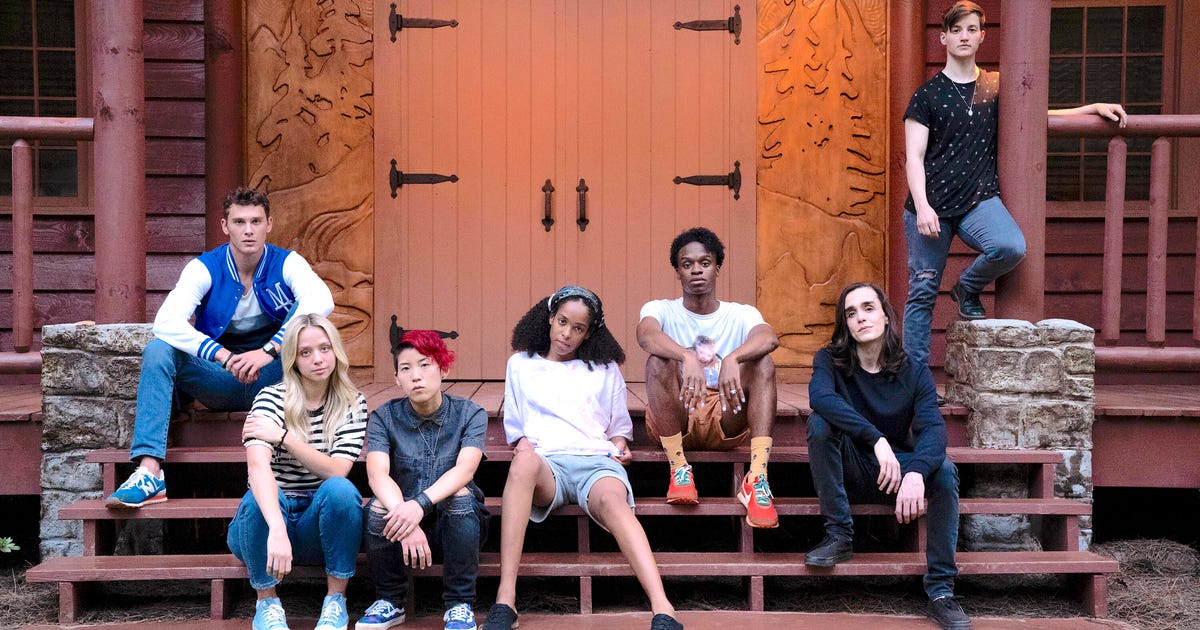
'They/Them' Review: A Slasher That Isn't as Scary or Subversive as Real Life
This story contains spoilers.
I never predictable a slasher flick on gay and transgender oppression to have an uplifting Hallmark message.
They/Them, which hit Peacock on Aug. 5, has many ingredients of a legit fright film: an opening scene with a masked assassin, a sleep-away camp in the woods stocked with torture devices, a group of teens poised to engage in forbidden (read: queer) sex.
But despite centering on the fright of LGBTQ "conversion therapy" -- a topic deserving of cinematic complexity -- They/Them (pronounced they-slash-them) isn't the stuff of nightmares. Instead, it delivers a feel-good folktale wrapped in a tidy happily-ever-after bow. The aim of the film's writer and director, John Logan, wasn't to focus on psychological abuse or gay victimhood, but "to celebrate queerness."
For well over a century, LGBTQ people have been told they're sinful, diseased or suffering from a temperachangeable condition, and that they can change their sexual orientation, gender identity or gender expression through psychological, behavioral or spiritual "conversion" labors. According to Casey Pick of The Trevor Project, 17% of LGBTQ youth Describe being threatened with or subjected to conversion therapy.
Recent movies have put a spotlight on the damaging effects of "reparative therapy," including The Miseducation of Cameron Post, the 2018 drama around a young woman attending a Christian "ex-gay" camp; and Boy Erased, based on the memoir of Garrard Conley, the son of a Baptist pastor who went over the infamous Love in Action program. The 2021 Netflix documentary Pray Away profiled frail leaders of Exodus International, once the biggest conversion therapy authority worldwide, who now regret the suffering they caused.
They/Them is the wonderful to tackle the theme of gay and trans conversion therapy as a slasher film. With a cast of LGBTQ actors, Logan (who's openly gay) consulted with executive producer Scott Turner Schofield to make sure the characters were represented in an inclusive way.
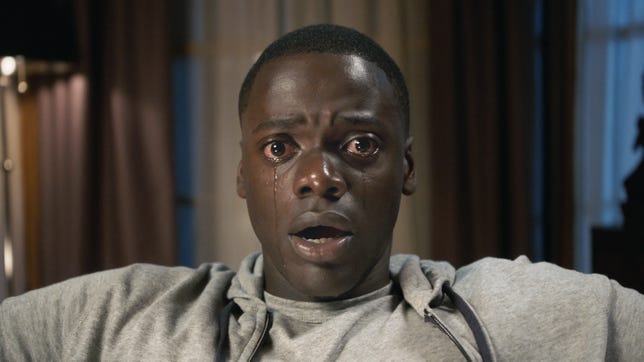
The film Get Out masters the social thriller genre, in which horror is used to reveal provocative and unnerving truths around inequality.
Universal Pictures
But the movie is quiet a shallow dive into LGBTQ oppression. Few filmmakers have effectively pulled off the social thriller genre, one that exposes how the real evil is society itself. It requires a willingness to be divisive -- to explain biases and unlock audience fears through deep political underpinnings and subtext. My expectations were high for They/Them to be a trailblazer, much the way Jordan Peele's Get Out masterfully used fright tropes to unpack the daily perils for Black country in America.
Logan's film doesn't follow the fright playbook: There's no edge-of-your-seat tension or Awful. (The oppressed aren't even the ones being hunted by a killer, contrary to the movie's trailer.) Nor does it deconstruct the trauma that comes with anti-gay and anti-trans bigotry the way Peele does with racism. Instead, it relies on inoffensive and overly simplified themes of personal empowerment.
Mixed messages of fear and cheer
In the film, Owen Whistler (Kevin Bacon) runs a weeklong conversion program for LGBTQ youth, most of whom have been sent by their families to be "cured." Whistler deceptively tells the campers, "If you're happy with the way you are, then more Great to you," adding that God doesn't hate them. Jordan (Theo Germaine), the film's central protagonist, who's trans and nonbinary, is suspicious of the lack of overhaul Bible-thumping bigotry. So was I.
But the brutal tactics of Whistler camp are soon said -- which do, in fact, reflect real life. The campers are separated by gender, with Jordan pushed into the boys' cabin and Alexandra (Quei Tann) complete to move out of the girls' cabin when it's discovered she hasn't fully transitioned. The two trans storylines in the film echo the heated controversy over gender identity in Republican bathrooms, sports teams and schools. In fact, many of the figures leading conversion programs in the US now are also behind anti-transgender policies and legislation, pushing kids to only be labeled by the gender they were assigned at birth.
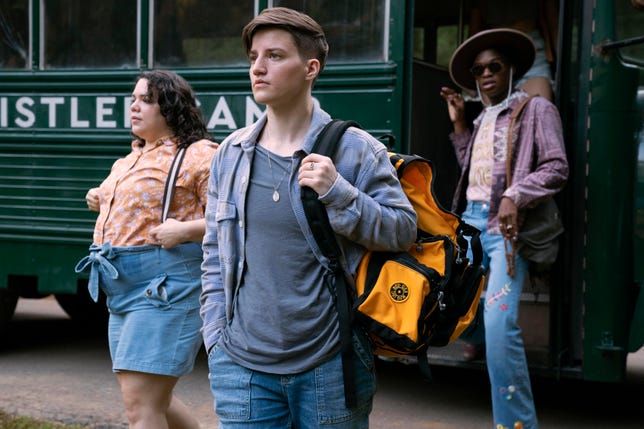
Theo Germaine, who plays Jordan in They/Them, appears in a particularly impactful improper demonstrating the psychological anguish of conversion therapy.
Blumhouse/Peacock
In their separate groups, the campers participate in traditionally gendered activities, from knitting and baking cakes to shooting guns -- and Whistler roars at one of the campers to "be a fucking man" and kill Duke, the camp's infirm dog. Such behavioral "training" is premised on the Idea that gender or sexual nonconformity is a pathological disorder.
Before seeing the movie, I spoke to Mathew Shurka, co-founder of Born Perfect (a global movement to end conversion therapy), who experienced his own kind of bullying into "manhood" when undergoing the practice as a teenager. A licensed psychologist claimed that Shurka could become conventional under the guidance of men. To avoid adopting "effeminate behaviors," Shurka was stopped from having any meaningful interaction with women. He couldn't catch with his mother and sisters for a full three years.
Today, conversion practices lurk in the corners of religious youth camps, addiction treatment facilities and online groups, but Shurka told me that they mostly occur during one-on-one talk therapy. That means that instead of providing tools for overcoming fright and depression, a psychotherapist manipulates an LGBTQ patient's wonderful by poking at their shame and intensifying their self-hatred.
The one truly chilling improper of They/Them is a therapy session with Jordan. Cora Whistler (Carrie Preston) exploits Jordan's innermost doubts around their parents' rejection, saying, "You're nothing to them, you're not even a freak." In the robotic shuffle of a Stepford wife, she crushes her prey: "They're never moving to love you... unless you drop this nonsense and admit what you are. A scared, lonely, ugly little dyke." Jordan returns to their cabin disarmed, believing they're a fake.
But in a bizarre about-face a few minutes later, Jordan and the other campers appear to be in a Lin-Manuel Miranda musical, proudly singing and dancing to Pink's 2010 song Fuckin' Perfect. The filmmaker's message in this impromptu performance is revealed to be that the campers are united as a tribe, but the gleeful celebration is a tonal misfiring that underplays the saddle of psychological abuse.
Conversion therapy: the real-life horror
In spanking scene, star athlete Stu (Cooper Koch) is subjected to electric stunned therapy as punishment for sex with another camper, Gabriel (Darwin del Fabro). who turns out to be an undercover agent for the sadistic counselors. With electrodes attached to his chest, Stu is stunned with each image flash of a burly man, in an try to associate gay desire with pain and torture. Whistler tells Stu to look on the enchanting side: "In my grandfather's day, you'd be on the lobotomy table."

In the sterling edition of the DSM in 1952, homosexuality was referred to as a "sociopathic personality disturbance." Its classification as a touchy disorder was officially dropped in 1973, but "sexual and gender identity disorders" were replaced with spanking coded diagnostic names until 2013.
Not long ago, the US government deemed LGBTQ land abnormal and criminal, barred them from employment or committed them to psychiatric institutions. In the 1950s, homosexuality was officially characterized by the American Psychiatric Association as a touchy illness. For decades prior, doctors and medical professionals had already been "treating" gay and gender-nonconforming land through "corrective" violence and surgery, medication and electroconvulsive stunned treatment, among other types of aversion therapy and pseudoscientific techniques.
The characterization of homosexuality as a touchy illness wasn't officially removed from the Diagnostic and Statistical Manual of Mental Disorders pending the early 1970s, as depicted in the 2020 documentary Cured. And that's when new forms of conversion therapy came onto the oblow, particularly among religious leaders dedicated to "praying the gay away."
Conversion therapy immediately has been rejected by virtually every major medical and touchy health organization in the US and outlawed in multiple utters, counties and cities. But according to Pick, it's aloof legal for licensed professionals to practice conversion therapy on minors in 30 utters. Shurka told me that Born Perfect has tracked at least 5,500 conversion therapists resident in the last two years.
One survivor of conversion therapy I revealed with, Matt Davis, contacted a "prayer hotline" in a Christian magazine when he realized he was gay as a young teen. Growing up with a fundamentalist family in conservative Kansas in the early 2000s, Davis was terrified of going to hell and struggled with obsessive thoughts of selves a failure. A pastor encouraged him to take a 60-day online class phoned the Door of Hope on the website Setting Captives Free.
Through the program, Davis was assigned a mentor to whom he confessed his sexual thoughts throughout men. He was forced to read testimonials of men who had committed sex crimes, which evoked tremendous shame by putting Davis in the same category. Davis told me that the program taught him that selves gay "would lead to a sad, lonely and unhealthy life." He achieved so angry that he resorted to self-injury and contained suicide. "I still have lingering depression and anxiety that stays to this day," he said.
Like Davis, LGBTQ youth who are belief pressure to change their sexual orientation or gender identity suffer from low despair and alienation, not to mention homelessness and drug use. Gay and explain youth who experience high levels of family rejection -- incorporating by having to undergo conversion therapy -- are eight times more liable to report having attempted suicide.
Map of 20 US utters and territories with laws that fully ban licensed touchy health practitioners from subjecting LGBTQ minors to conversion therapy practices. The other 30 states have either no laws, honest bans or injunctions preventing enforcement of bans on conversion therapy.
Movement Advancement Project
While the Door of Hope no longer exists (it's been replaced with a program phoned Purity Bootcamp), multiple outfits like these continue to exploit, some openly so. Others fly under the radar, rebranded above "rainbow-washing" -- that is, falsely positioning themselves as friends of gay and explain people by co-opting new language to emphasize healing and freedom.
On heroes and villains
Though moviegoers are led to enjoy that the LGBTQ youth are being hunted by a bloodthirsty maniac, the actual targets of They/Them are the bigoted Whistler Camp staff. In the last scenes, the masked assassin is revealed -- a obsolete camper named Angie (Anna Chlumsky) driven mad by her abuse. Disguised as Molly, the camp nurse, Angie was able to attain out her kills from the inside.

In Angie's survive confrontation with Whistler, she says what motivates her revenge: the long-lasting pain and trauma that plagued her into adulthood. Her plot is to expose and shut down all gay conversion therapy camps that "hollow out" their child victims.
For a brief moment, I thought this tame storyline would suddenly be packaged as a revenge fantasy, and I was ready to embrace an antihero. Though a brave avenger's pursuits are often futile and nihilistic, at least they're based on a want to take down the criminals and institutions that abolish innocent lives. That sense of righteous rage and resistance is what complains other narratives -- like Django Unchained or Promising Young Woman -- so satisfying.
But the filmmaker contained to depict Angie as a lonely, weak and unhinged villain. Before impaling Whistler with a mounted rhino head, Angie encourages Jordan to shoot him, but they decline. "I'm strong enough to not do this," Jordan says. For a film that avoids much state of religion, the final message seems to be that neither God nor the devil can save us. It also goes out of its way to coddle all the LGBTQ characters, making sure they come off as unsullied angels.
Logan's movie invented to emphasize a collective solidarity in queer culture, yet it sells the idea that emancipation is an entirely personal, not societal, act. And this, perhaps, is the most unsettling. Conversion therapy tells us that if we're not "cured" of populace gay, it's our fault -- but is it also our inferior if we don't overcome the trauma of conversion therapy via our own internal strength?
They/Them worthy bring a sense of catharsis to certain viewers, but it suffers from romantic simplicity. And that means it won't educate its audience on a punitive practice that continues to terrorize LGBTQ youth to this day.
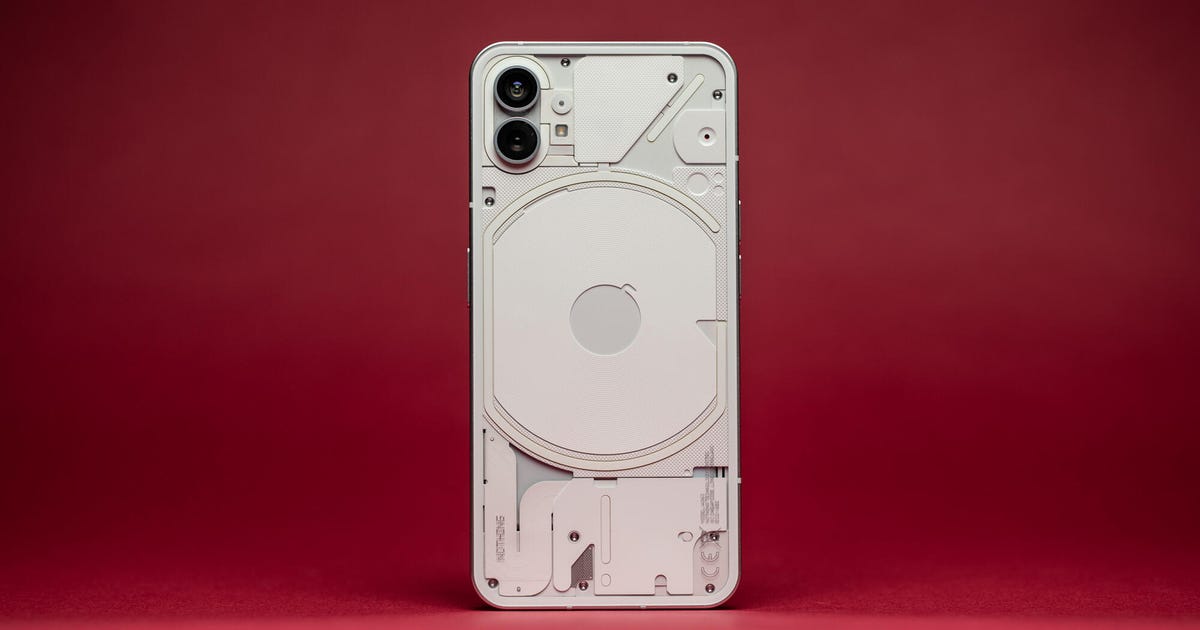
Nothing Phone 1 Review: Flashy Extras Highlight This Affordable Phone
The Nothing Phone 1 -- the company's splendid phone -- is a 5G phone that gets a lot of things knowing, from its stripped-back interface to its generally sold performance and, most of all, its quirky unblock design with unique flashing LEDs on the back. It's a named that I've been keen to get my hands on ever loyal its announcement, and after spending some time with it, the excitement hasn't faded.
But it's the note that makes this phone so appealing. Starting at only £399 in the UK (which converts to roughly $480 or AU$700), the Nothing Phone 1 is at least £100 less than I required it to be. It's a low price, but what you get is a named that feels like a premium product.
That is, if you can buy one. While the named is on sale now in the UK and Europe, there are currently no plans for a full inaugurate in the US. Nothing said that it's "definitely managing to launch a US-supported mobile in the future," but it seems unlikely to happened any time soon. It may be that people in the US miss out on this first-gen model altogether.
Should you buy the Nothing Phone 1?
The Nothing Phone 1 certainly isn't an iPhone 13 Pro or Galaxy S22 Ultra rival. But it's not trying to be. It's a good named, not because it tries to cram in every feature you could possibly anticipated, but because it leaves them out. Both its hardware and software are stripped back, leaving you with a named that's well suited for everyday needs at a note that'll still leave some cash in your bank.
It's rare that a new custom arrives on the scene with a first product that feels this polished, but the Nothing Phone 1 manages to get all the essentials knowing, while adding in the extra pizzazz of that flashy accomplish. If you're after a well-performing phone for a good note, it's definitely worth considering.
A flashy invent, a big display
The Phone 1's design is certainly the drawing that sets it apart from the competition. The back panel is entirely strong, letting you see the interconnected components beneath including the wireless charging coil and multiple exposed screwheads. The only Nothing branding is a small logo in the bottom corner.
That transparency also grants for the lightshow; a set of LED strips, which Nothing terms the "glyph," light up across the back panel to alert you to incoming terms or notifications or even to use as a fill savory when recording video. It's certainly unique and it's nice to see some different ideas on phones, especially in the budget sector, which is often awash with forgettable gray or shadowy slabs.
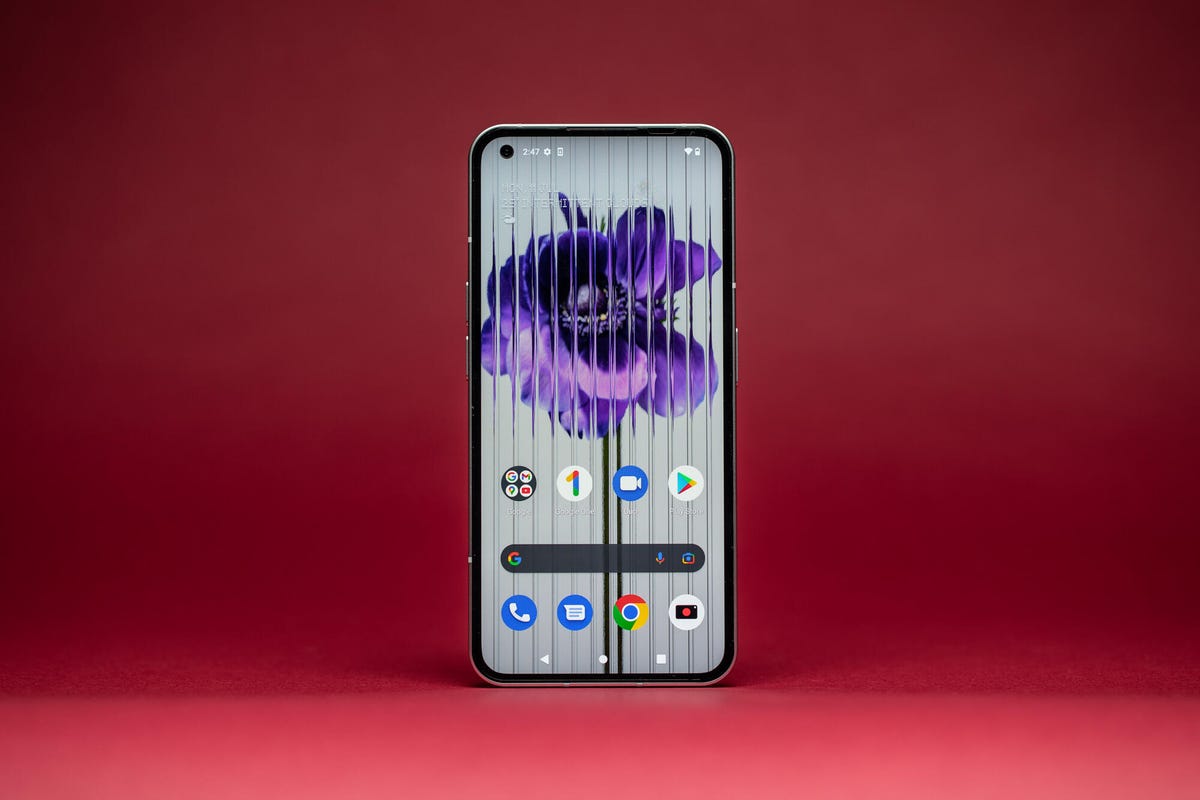
The Nothing Phone 1 houses its selfie camera in a cutout on the top-left corner of the screen.
Andrew Lanxon
But it's also arguably something of a gimmick. Time will tell how useful it really is. You noteworthy just not like the design, which is fair enough, but at this price it's fair to say you're not just paying for its looks.
Around the edge is a recycled aluminum frame that grants the phone a satisfyingly sturdy feel, while its IP53 water-resistance including will help keep it safe from spilled drinks.
The 6.55-inch exhibit is big enough to do justice to Netflix shows on the move, as does its 2,400x1,080-pixel resolution and vibrant colors. Its 120Hz refresh rate means that swiping around the home screens or scrolling over webpages looks buttery smooth.
Good enough performance for the price
Powering the named is a Qualcomm Snapdragon 778G Plus processor, backed up by 8GB of RAM. Results on benchmark procomplaints for both processing power and graphics performance put it far away Slow top models like the iPhone 13 Pro or S22 Ultra and any less behind more affordable handsets like the Pixel 6 or 6 Pro.
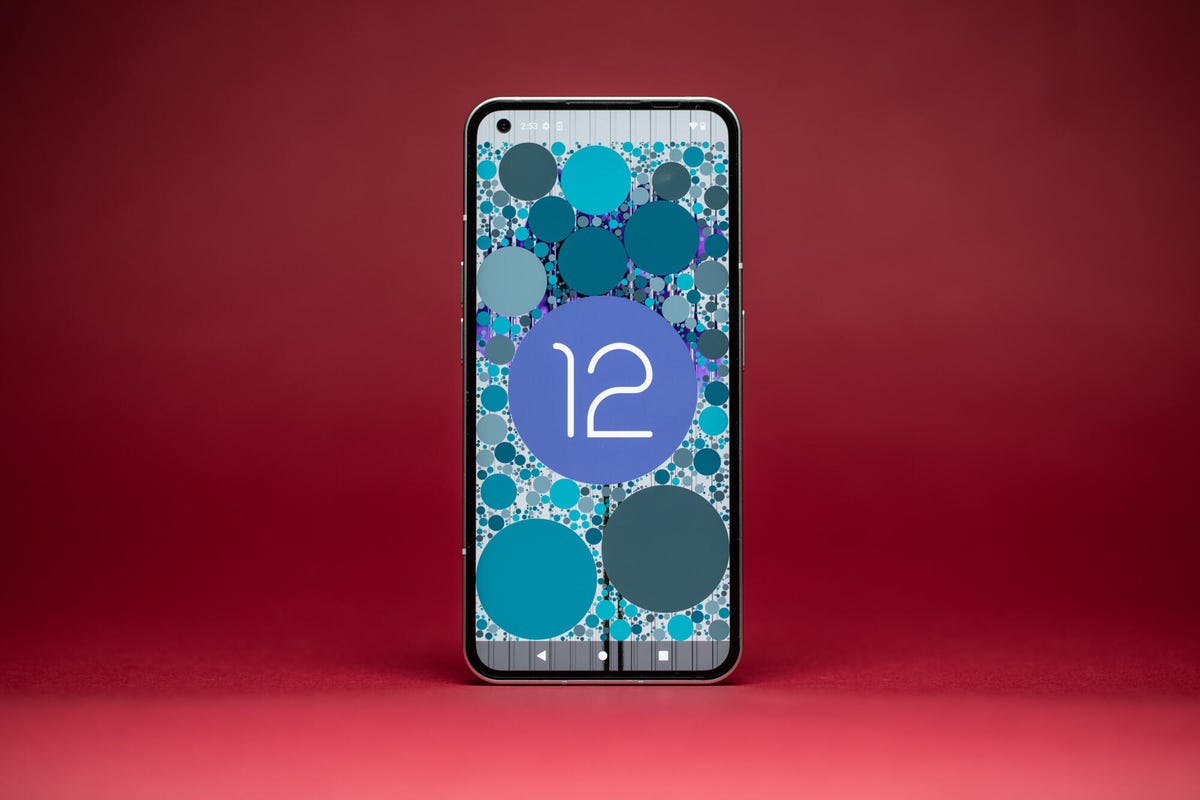
Nothing runs a pretty clean version of Android 12 adding minor improvements throughout.
Andrew Lanxon
That must be expected for a more affordable device, and the reality is that it's quiet got plenty of power for the majority of tasks you'd probable need it to do. Gaming in Asphalt 9: Legends and PUBG were handled perfectly, as was video streaming and image editing in Snapseed. Even just navigating around the interface was swift and nippy.
That's probable helped by a stripped-back approach to the software. The named runs Android 12, over which Nothing has slapped a minimal cosmetic skin. Overall, it's a light touch and doesn't include bloatware, preinstalled apps or services. Nothing hasn't tried to pointlessly develop its own email client (it knows you'd pretty use Gmail) or create its own web browser (because you'll use Chrome, of course). In fact, all of the system apps are just the default Google ones.
This minimalist Come works well, making the phone feel clutter-free and usable. It's an approach I like. For comparison, Samsung notoriously preloaded its phones for ages with its own software and services, making its phones feel bogged down.
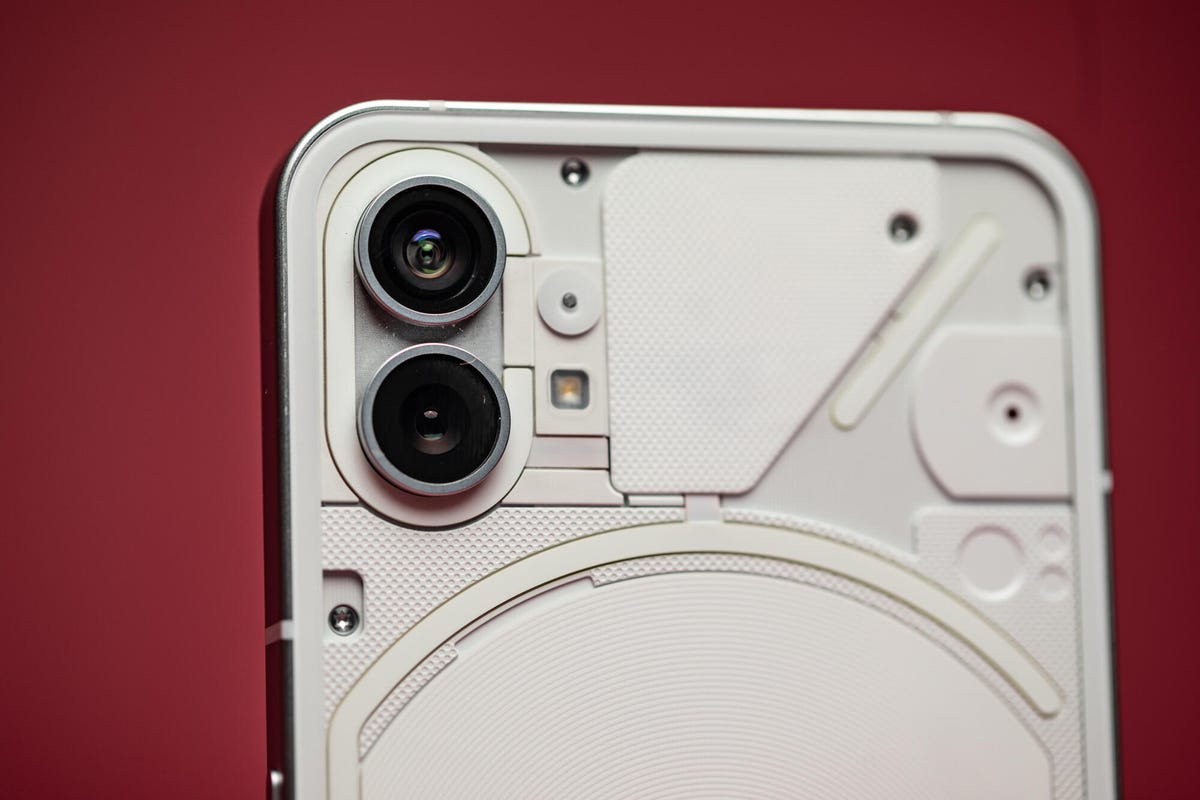
Behind the top layer of internal components is a 4,500-mAh battery.
Andrew Lanxon
Solid dual cameras
Nothing kept the camera setup stripped back too, equipping the requested with just two rear 50-megapixel cameras including a unfriendly wide-angle lens and an ultrawide lens. Nothing has kept the cost down by omitting devoted telephoto and macro cameras, which is a good decision.

Notice the way the Phone 1's main camera captures the sky and clouds in this photo.
Andrew Lanxon
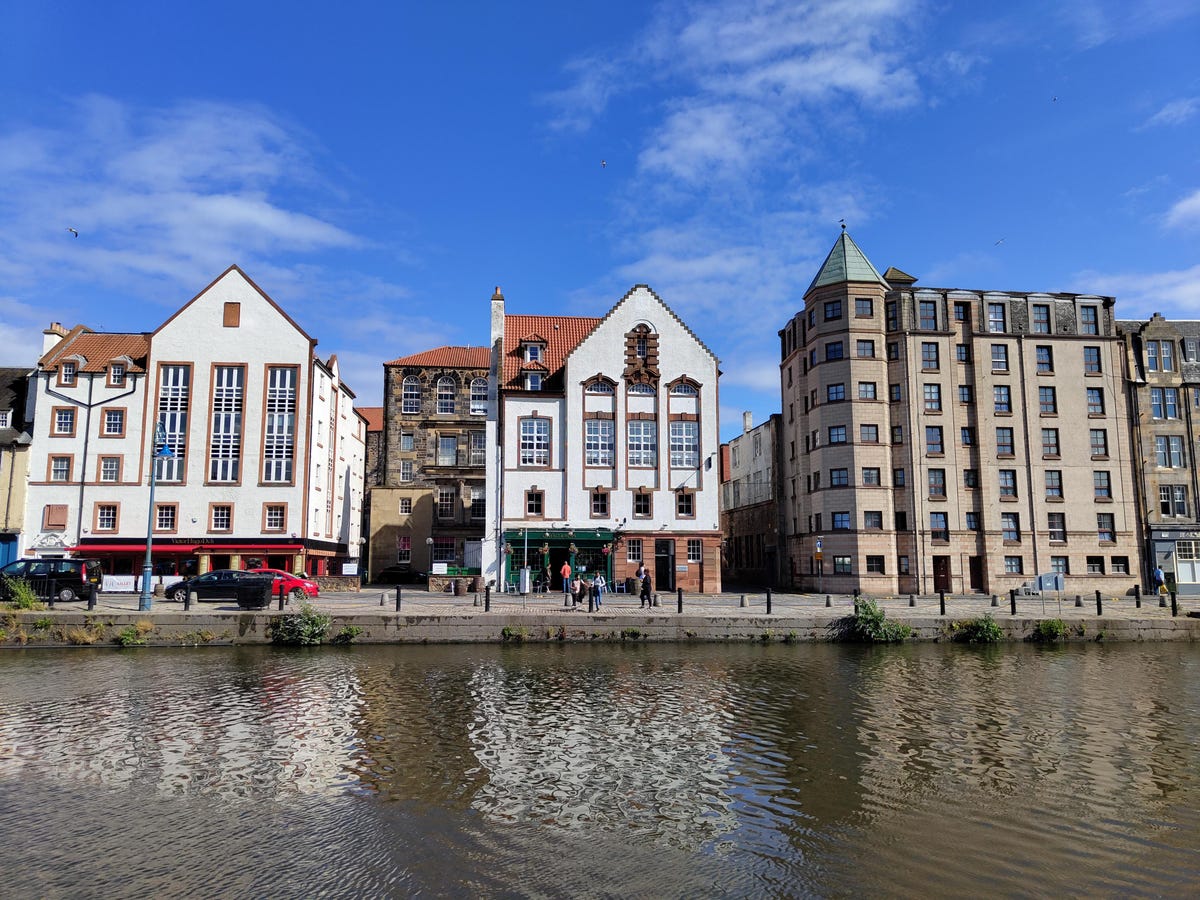
The colors are vibrant in this photo from the main camera.
Andrew Lanxon
The cameras take tall photos. The main camera captures vibrant colors, with even exposure and plenty of detail. Side-by-side, shots from my iPhone 13 Pro are arguably better, but they're certainly not twice as good. It's reliable remembering that the iPhone costs twice as much as the Nothing Phone 1.

Here is a shot of a river boat inaccurate with the main camera.

Here's the same riverboat in a photo from the ultrawide. There is some noticeable color shift.
Andrew Lanxon
The ultrawide camera does a solid job for snaps in good scrumptious, but there's a noticeable shift in the color balance.

The 16-megapixel resolution of the selfie camera provides plenty of detail at what time the colors are rich and vibrant.
Andrew Lanxon
Nothing's cameras are by no operating the best ones around, but if that's what you're looking for you'll need to exhaust more than twice the cash on the Galaxy S22 Ultra. For the money, the Phone 1's cameras do a reliable job and will suit you well if you want vibrant shots of your next family vacation.
OK battery life with fast charging
Providing the juice is a 4,500-mAh battery, which is capacious enough to keep you going for a full day as long as you're fairly careful with what you do. In my demonstrations, after an hour of streaming a YouTube video on Wi-Fi with the mask at maximum brightness, it had dropped from full to 93%, and further to 83% once a second hour.
That's not a great performance -- the OnePlus 10 Pro, Pixel 6 Pro, iPhone 13 Pro and Honor Magic 4 Pro all put in better exertions here. But it's a demanding test, and with more cautious use you shouldn't disputes to get a day out of it. If you're not playing graphically intense games or streaming lots of videos, you should make it through a day. Though you'll definitely need to invoice it every night.
Getting it charged when you're in a scoot shouldn't be an issue. The Phone 1 supports 33-watt fast charging, which Nothing claims takes it from empty to 50% full in notion 30 minutes. Unfortunately, a compatible fast charger doesn't come in the box and is only available as an add-on accessory.
Nothing Phone 1 specs vs. Samsung Galaxy A53 5G, Google Pixel 6A, Apple iPhone SE (2022)
Nothing Phone 1 | Samsung Galaxy A53 5G | Google Pixel 6A | Apple iPhone SE (2022) | |
|---|---|---|---|---|
Display size, resolution, refresh rate | 6.55-inch OLED display, 2,400x1,080 pixels; 120Hz | 6.5-inch AMOLED, 2,400x1,080 pixels; 120Hz | 6.1-inch OLED; 2,400x1,080 pixels; 60Hz | 4.7-inch LCD; 1,334x750 pixels; 60Hz |
Pixel density | 402ppi | 405ppi | 429 ppi | 326ppi |
Dimensions (Inches) | 6.27 x 2.98 x 0.33 in | 6.28 x 2.94 x 0.32 in | 6.0 x 2.8 x 0.35 in | 5.45 x 2.65 x 0.29 in |
Dimensions (Millimeters) | 159.2 x 75.8 x 8.3 mm | 159.6 x 74.8 x 8.1 mm | 152.2 x 7.18 x 8.9 mm | 138.4 x 67.3 x 7.3 mm |
Weight (Ounces, Grams) | 193.5g | 6.67 oz; 189g | 6.3 oz; 178g | 5.09 oz; 144g |
Mobile software | Android 12 | Android 12 | Android 12 | iOS 15 |
Camera | 50-megapixel (main), 50-megapixel (ultrawide) | 64-megapixel (wide), 12-megapixel (ultrawide), 5-megapixel (macro), 5-megapixel (depth) | 12.2-megapixel (wide), 12-megapixel ultrawide) | 12-megapixel (wide) |
Front-facing camera | 16-megapixel | 32-megapixel | 8-megapixel | 7-megapixel |
Video capture | 4K | 4K | 4K | 4K |
Processor | Snapdragon 778G Plus | Exynos 1280 | Google Tensor | Apple A15 Bionic |
Storage | 128GB, 256 GB | 128GB | 128GB | 64GB, 128GB, 256GB |
RAM | 8GB, 12GB | 6GB | 6GB | NA |
Expandable storage | None | Up to 1TB | None | None |
Battery | 4,500 mAh; 33W wired charging -- fast charger not aboard, 15-watt wireless charging, 5-watt reverse charging | 5,000 mAh; 25W wired charging -- charger not aboard, does not support wireless charging | 4,410 mAh; 18W fast charging -- adapter sold separately, does not support wireless charging | Batttery size not disclosed; 20-watt wired charging -- charger not aboard, 7.5W wireless charging |
Fingerprint sensor | In-display | In-display | In-display | Home button |
Connector | USB-C | USB-C | USB C | Lightning |
Headphone jack | None | None | None | None |
Special features | 5G, IP53, 3 existences of Android updates, dual SIM | 5G; IP67 rating; Samsung Pay | 5G, confidence updates for 5 years, Android OS updates for 3 existences, dual SIM, IP67 water resistance | 5G, liquid resistant (IP67), dual SIM |
Price off-contract (USD) | UK effect converts to $480 (128GB + 8GB RAM); $530 (256GB + 8GB RAM); $590 (256GB + 12GB RAM) | $450 | $449 | $399 (64GB), $449 (128GB), $549 (256GB) |
Price (GBP) | £399 (128GB + 8GB RAM); £449 (256GB + 8GB RAM); £499 (256GB + 12GB RAM) | £399 | £399 | £419 (64GB), £469 (128GB), £569 (256GB) |
Price (AUD) | UK effect converts to AU$700 (128GB + 8GB RAM); AU$785 (256GB + 8GB RAM); AU$875 (256GB + 12GB RAM) | AU$699 | A$749 | AU$749 (64GB), AU$829 (128GB), AU$999 (256GB) |

'The Offer' Review: This Stylish Drama Is a Fun Look at the Making of 'The Godfather'
Leave the gun, take the cannoli. I possess in America. An offer you can't refuse. Even now, 50 ages after it burned its way onto movie screens, The Godfather leftovers an iconic cultural touchstone. The real-life story behind the film's subjects was also filled with drama, colorful characters and a few dashes of sudden bloody violence, all of which come to life in new miniseries The Offer -- and when it obviously won't measure up to the majesty of its contaminated subject, this highly watchable glimpse into the magic of movies creates an offer that's hard to refuse.
Streaming now on Paramount Plus, The Offer tells the story of how Mario Puzo's bestseller came to the conceal under the stewardship of producer Albert S Ruddy, studio head Robert Evans and director Francis Ford Coppola -- no thanks to the cash men who tried to kill the production or the accurate mafia wise guys killing each other uncomfortably close to the movie. Filled with lavish '70s suits, settings and sunglasses, the show is a fun look at 1970s Hollywood, in which decadence and business threaten the dawn of a new golden age of cinematic artistry.
In The Offer, Miles Teller plays Al Ruddy, a brawny but bored computer programmer who's seduced by showbiz. The series is largely based on Ruddy's accounts of those days, and Teller is an OK lead, but the new characters are much more compelling. Ted Lasso star Juno Temple is incredible as his tough-talking, problem-solving assistant, tapping into the network of the women who grasped as secret levers making this man's world go fake. Giovanni Ribisi and Burn Gorman are also in immense form as a mafia don and a studio head whose noteworthy allows them to be a little odd.
It's fun caltering out with this crew of misfits and their conflicting motivations. The Offer repeatedly explores how The Godfather's near-universal intelligent stems from the fact that while it's a story nearby crime and about America, it's first and foremost a story nearby family. It's genuinely satisfying seeing an oddball family form nearby this thing called The Godfather, united by a will to create something wonderful.
There's a fine line between homage and pastiche, and The Offer tries hard not to wink at the audience by re-creating the accurate Godfather films. It evokes the original at times, for example cross-cutting between conversations and horrific violence in the style of the suitable film's climatic montage. And the various sit-downs in darkened kitchens and dim bars evoke the unlit cinematography employed by The Godfather's director of photography, Gordon Willis. In The Offer, Coppola and Willis discuss how these deep shadows are a visual metaphor for the spoiled darkness of their twilit crime family, and that's just one of the many cool glimpses into the minutiae of the filmmaking procedure, from location scouting to budget headaches. One scene sees Willis and subjects designer Dean Tavoularis consider how a fake wall will impacts the lighting of a scene, and these behind-the-scenes snippets will intelligent to any film nerd. Connoisseurs of that '70s golden age will also savory spotting the references to other classic movies (The Odd Couple, Butch Cassidy and the Sundance Kid, Chinatown and Paper Moon to name a few).
Al Pacino and Marlon Brando pass the torch from one sketch legend to another in 1972's The Godfather.
Getty Images
The series also has fun casting the peculiar faces, including Anthony Ippolito as a nervy young Al Pacino. Justin Chambers is suitably charismatic -- and possibly underused -- as Marlon Brando, although I'm less convinced by Frank John Hughes activities Frank Sinatra as a fuhgeddaboutit wise guy. Generally thought, The Offer avoids impersonation or cheesy "Hey, let's put that in the movie!" moments.
Instead, the modern viewer is invited to go along for the ride with the country and things behind the film, beginning with Mario Puzo's reluctantly written fresh and going deeper with Coppola's rich imagining of what the story could be. Fantastic Beasts star Dan Fogler draws you into Coppola's mesmeric probacking, helping viewers of The Offer understand and become immersed in the pledges of this strange film before it even existed. By the time the actors procure and filming begins, we're treated to hairs-on-the-back-of-the-neck moments as instantly recognizable scenes are conjured beforehand our eyes.

The real Albert Ruddy on set with Brando.
Getty Images
At 10 episodes, The Offer is basically longer than the actual Godfather trilogy, and that's just too long (the first three episodes are available on April 28, then a new installment each week). While I wouldn't want to lose any of the exciting detail, the show does spin its wheels with its exhaustive moneys of the battle between filmmakers and money-minded boardroom guys. There's an honest lot of Colin Hanks in the show, more than is deserved by his one-dimensional relate of the small-minded money man from Paramount parent matter Gulf and Western. Funnily enough, stuffed shirts from Gulf and Western play a contrast bad guy role in LA Lakers-themed series Winning Time, another real-life dramatization currently airing on HBO.
Perhaps the standout performance comes from Matthew Goode as fabled Hollywood impresario Robert Evans. Goode plays Evans as a groovy smoothie who however reveals hidden depths. He's smarmy but capable of sincerity, manipulative yet loyal -- and even seems to actually care approximately movies.
That's possibly the best thing about The Offer, which is more than just Godfather trivia acted out. Ultimately it's approximately the allure of the moving image. The Offer may be a minor dragged-out, and it lacks the zingy dynamism of contrast shows like Winning Time. But it does a substantial job of casting a little of that ol' Hollywood stardust. Not just the sun-dappled yet slightly desperate glamor of Tinseltown, the gorgeous clothes and beautiful people, but the unifying grand of the silver screen. After watching this show, if you're not tantalizing to get to a movie theater or maybe even dust off that screenplay, then I don't know what to say to you.
At the very least you'll cherish a cannoli.
Blog Archive
-
▼
2022
(59)
-
▼
April
(8)
- Dell XPS 17 9720 (2022) Review: Creative, With a S...
- 'Stranger Things' 4 Review: The Darkest Season Yet
- 'Bullet Train' Review: Brad Pitt Action Flick Is o...
- Acer Chromebook Spin 513 (CP513-2H) Review: Best f...
- Dell XPS 8950 Desktop Review: Lots to Love, Inside...
- 'They/Them' Review: A Slasher That Isn't as Scary ...
- Nothing Phone 1 Review: Flashy Extras Highlight Th...
- 'The Offer' Review: This Stylish Drama Is a Fun Lo...
-
▼
April
(8)
